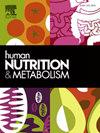中国2型糖尿病人群中营养摄入与白内障的关系
IF 1.8
Q3 ENDOCRINOLOGY & METABOLISM
引用次数: 0
摘要
目的探讨中国糖尿病人群每日营养摄入(包括抗氧化剂、矿物质和其他必需营养素)与白内障发展之间的关系。方法2010年1月至2011年1月,从中国城市社区招募398例2型糖尿病患者。参与者接受了标准化评估,包括问卷调查、眼部和人体测量检查以及实验室测试。采用3 d饮食记录法收集饮食数据。根据晶状体混浊分级系统III对核性、皮质性和后囊下性白内障(PSC)进行分级。采用多变量logistic回归分析了每种膳食营养素与白内障发展之间的关系,并在不同模型中调整了社会人口因素、生活方式、糖尿病发病年龄和糖尿病相关生物标志物。结果白内障组230例,非白内障组168例。白内障组平均年龄(68.3±6.4岁)高于非白内障组(59.4±9.4岁),P <;0.001)。糖尿病视网膜病变患者PSC加重(P = 0.020)。膳食维生素C与核性白内障呈正相关(P <;所有模型均为0.05)。核黄素(P = 0.023)和磷(P = 0.026)与皮质性白内障相关,磷(P = 0.043)和叶酸(P = 0.044)与PSC型白内障相关。其他营养物质没有发现关联。结论膳食维生素C与核性白内障风险增加有关,核黄素和磷与皮质性白内障风险增加有关,磷和叶酸与PSC白内障风险增加有关。糖尿病视网膜病变患者白内障的严重程度更为明显。本文章由计算机程序翻译,如有差异,请以英文原文为准。
Association between nutrient intake and cataracts in a Chinese type 2 diabetic population
Objectives
This study investigates the association between daily nutrient intake, including antioxidants, minerals, and other essential nutrients, and cataract development in a diabetic Chinese population.
Methods
A total of 398 patients with type 2 diabetes from an urban Chinese community were recruited between January 2010 and January 2011. Participants underwent standardized evaluation, including questionnaires, ocular and anthropometric examinations, and laboratory tests. Dietary data were collected by 3-day food records. Cataract including nuclear, cortical, and posterior subcapsular cataracts (PSC), were graded according to Lens Opacities Classification System III. Multivariable logistic regressions were conducted to analyze associations between each dietary nutrient and cataract development, adjusting for social-demographic factors, lifestyle, age at onset of diabetes, and diabetes-related biomarkers in different models.
Results
Of the participants, 230 were in the cataract group, while 168 in the non-cataract group. The mean age was higher in the cataract group (68.3 ± 6.4 years) compared to non-cataract group (59.4 ± 9.4 years, P < 0.001). PSC were more severe in patients with diabetic retinopathy (P = 0.020). Dietary vitamin C was positively associated with nuclear cataracts (P < 0.05 across all models). Riboflavin (P = 0.023) and phosphorus (P = 0.026) were associated with cortical cataracts, while phosphorus (P = 0.043) and folic acid (P = 0.044) were associated with PSC cataracts. No associations were found for other nutrients.
Conclusions
Dietary vitamin C was associated with an increased risk of nuclear cataracts, while riboflavin and phosphorus were linked to cortical cataracts, phosphorus and folic acid were associated with PSC cataract. The severity of cataracts was more pronounced in patients with diabetic retinopathy.
求助全文
通过发布文献求助,成功后即可免费获取论文全文。
去求助
来源期刊

Human Nutrition and Metabolism
Agricultural and Biological Sciences-Food Science
CiteScore
1.50
自引率
0.00%
发文量
30
审稿时长
188 days
 求助内容:
求助内容: 应助结果提醒方式:
应助结果提醒方式:


